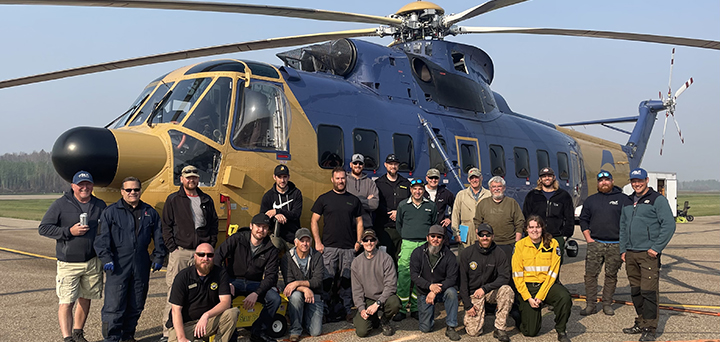
For Immediate Release: June 9, 2023
Contact: Carrie Bilbao, cbilbao@blm.gov, 208-387-5457
U.S. fire resources continue to support Canada
Boise, Idaho - The National Interagency Coordination Center, located at the National Interagency Fire Center (NIFC) continues to mobilize wildfire suppression resources to Canada. The National Multi-Agency Coordinating Group (NMAC), at NIFC, is working with federal wildland fire agencies to fill requests as they are received from the Canadian Interagency Forest Fire Centre (CIFFC) located in Winnipeg, Manitoba. At this time, there are approximately 345 federal firefighters and support personnel assigned to various wildfires in Canada. The CIFFC remains at Preparedness Level 5 due to continued hot, dry conditions and extreme fire activity that is being observed on many incidents across all provinces and territories in Canada.
“Through our long-standing arrangement and excellent relationship, we have been sending equipment and federal fire personnel to help our Canadian neighbors since the second week of May,” said Jeff Arnberger, NMAC Chair. “We are more than willing to provide Canada as many resources as we can as they have done for us in the past. We have been fortunate to have a slow start to our fire year nationally. However, as we head into traditionally busy months of summer, we must also be prepared for wildfires in the U.S. We continue to assess our situation daily and are extremely thankful that our state partners are also providing much needed resources to Canada through their compact agreements.”
In addition to the federal firefighting resources mobilized, state wildland fire agencies continue to provide personnel and equipment to support the wildfires burning in Canada, via forest fire compact agreements. These agreements allow U.S. states and Canadian provinces to share fire resources as needed without having to provide a formal request through NIFC. Currently, state forest fire compacts have provided more than 100 firefighting personnel and equipment to Alberta, Nova Scotia and Quebec including four airtankers from Alaska and Washington. The Northeast Compact provided a 17-person fire suppression crew to Nova Scotia from the states of Connecticut, New York, Maine, and New Hampshire and is assembling an additional hand crew for response to Quebec. The Great Lakes Compact consisting of the states of Minnesota, Wisconsin, and Michigan, is on alert to provide aircraft between states and provinces depending on the need.
Since May 8, the U.S. has mobilized a total of 649 personnel via the CIFFC/NIFC agreement to Alberta and the CIFFC, which includes: 27 fire suppression crews (548 personnel), 41 individual overhead, and four incident management teams (60 personnel). Currently, not including resources returning to the U.S. there are: 13 fire suppression crews (322 personnel), seven overhead, and one incident management team (16 personnel). This number will fluctuate daily as we have resources returning and responding to requests.
As smoke from Canadian wildfires continues to impact various areas in the U.S., air quality information about wildfire smoke can be found on AirNow at https://www.airnow.gov/wildfires/.
For the most current information concerning the wildfires burning in Canada, please visit the Canadian Interagency Forest Fire Centre webpage at https://ciffc.net/.








